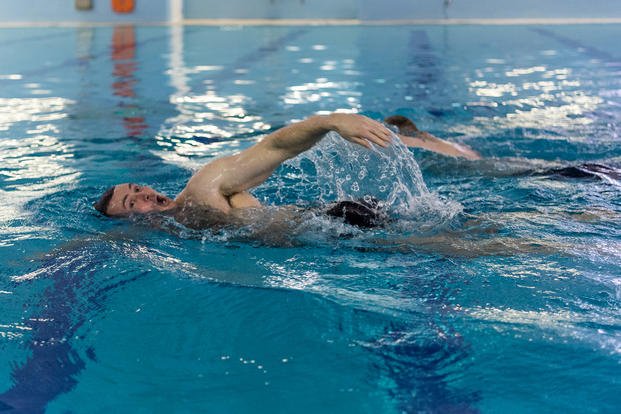The combat swimmer stroke (CSS) is really the nickname for a modified version of the side stroke.
If you have ever seen military special ops (SEALs, EOD, SF, RECON, etc.) swimming with fins on the surface, chances are that it is some version of this underwater recovery stroke. In a nutshell, it is a mix of the side stroke, breaststroke, and freestyle all rolled into one very efficient and fast swim stroke that enables Special Ops swimmers to move in the water without splashes and a low profile.
Here is a three-part breakdown video of the combat swimmer stroke so you understand the modified elements compared to the elementary side stroke. Watch a video of the CSS — 3-Part Breakdown
The question received this week concerns how to get faster at the 500-yard swim for the Navy BUD/S, EOD and diver test.
Stew, I am preparing to take the BUD/S PST and finally learned the CSS. I can get 50 yards in 5-6 strokes and in 50 seconds or less, but my time for the 500 yard is still in the high 9 minutes. Any advice? I feel I have the technique down; how do I maintain that pace?
Conditioning: This is what I call the first step at swimming sub-eight minutes on the CSS 500-yard swim test. What your stroke count, length and time per 50 yards tell me is that your technique is capable of handling a 8:20 or less, 500-yard swim, but your lungs are not. It is now all about conditioning.
Assessment drill: Here is a drill for you to do the next time you are in the pool. Swim 500 yards like you would for the test. Have someone mark down your times at each lap. We do this all the time, as it tells me where you are falling off your pace and where you need to focus your workout distances when you swim. One of our guys currently has the exact same problem as you do, and his scores were recently the following . A typical 500-yard swim will look like this for you, I bet:
| 1) :50 | 2) 1:40 | 3) 2:30 | 4) 3:22 | 5) 4:20 |
| 6) 5:20 | 7) 6:20 | 8) 7:30 | 9) 8:40 | 10) 9:50 |
As you can see, you start off on perfect pace at 50 seconds (8:20 pace) and maintain it pretty well for 200-250 yards. A better split would be 4:10 obviously, but being just 10 seconds under at this point is still a sub-nine-minute pace. But you fall apart on the last half of the swim. Your average 50-yard swim from 250-500 yards is 1:00-1:10.
Here is the progression of workouts from taking a technically sound, 50-yard swim at a goal pace of 50 seconds and conditioning the lungs to handle the entire 500-yard swim in 8:20. We do this with 1,500- to 2,000-yard workouts each day.
| Maintaining Pace 50-100 yards | Maintaining Pace 100-200 yards | Maintaining Pace 250-300 yards | Maintaining pace for 500 yards |
| Warmup with a 500-yard swim
Repeat 10 times Repeat 5 times Cooldown technique swim - swim easy 500yds but focus on strokes per length and good kick offs the wall / glides. |
Warmup with a 500-yard swim
Repeat 5 times Repeat 5 times |
Warmup with a 500yd swim
Repeat 2 times Repeat 10 times |
If you want to break 8 minutes -- do the same cycle from the left to right of this chart but make your pace: :45 per 50 yards = 7:30 pace Also -- start swimming with fins to get the ankles used to the SCUBA fins you will be wearing in any Navy Spec Ops training. Build up to 2-mile swims with fins. |
Change it up each day. However you change the swim sets, make sure you focus on your goal pace at a certain distance where you failed in your assessment 500-yard test.
Put it all together: This is how it looks when you master the technique and master the conditioning. These particular swimmers are swimming sub-eight minutes, with one flirting with seven minutes flat for the 500-yard CSS. (video link)
Stew Smith is a former Navy SEAL and fitness author certified as a Strength and Conditioning Specialist (CSCS) with the National Strength and Conditioning Association. Visit his Fitness eBook store if you’re looking to start a workout program to create a healthy lifestyle. Send your fitness questions to stew@stewsmith.com.
Want to Learn More About Military Life?
Whether you're thinking of joining the military, looking for fitness and basic training tips, or keeping up with military life and benefits, Military.com has you covered. Subscribe to Military.com to have military news, updates and resources delivered directly to your inbox.


















